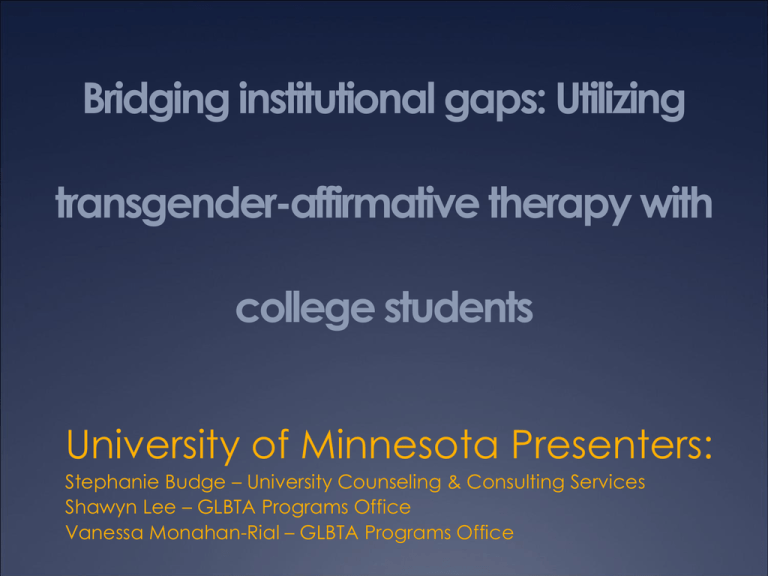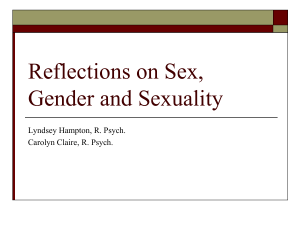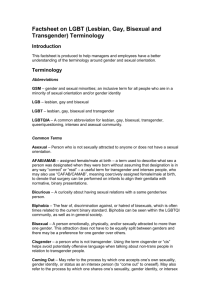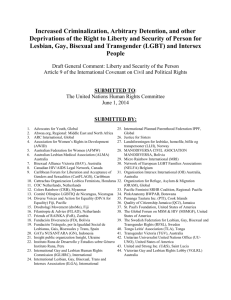
Bridging institutional gaps: Utilizing
transgender-affirmative therapy with
college students
University of Minnesota Presenters:
Stephanie Budge – University Counseling & Consulting Services
Shawyn Lee – GLBTA Programs Office
Vanessa Monahan-Rial – GLBTA Programs Office
HOW DO WE TRADITIONALLY
UNDERSTAND GENDER &
SEXUALITY?
American society traditionally subscribes to the theory of
Gender Essentialism
“Gender” can be used interchangeably with “Sex”
Why? Because both are rooted in nature and are
essentially, naturally, and biologically linked
Rooted in binaries of “male” and “female”
Sex, gender and sexual orientation are three separate
components of our gender and sexual identities
GENDER
SEX
Body / Biology
SEXUAL ORIENTATION
Attractions / Relationships
Culture
SEX: BODY / BIOLOGY
•
What is Sex?
– Category assigned to each of us at birth based on a variety
of physical and biological characteristics
Components
Chromosomes
Genitals
Hormones
Reproductive Organs
Secondary Sex
Characteristics
Variations
Female
Male
Intersex
SEX: BODY / BIOLOGY
What is Intersex?
A general term used for a variety of conditions in
which a person is born with a reproductive or
sexual anatomy that does not seem to fit the
typical definitions of female or male
Source: Intersex Society of North America
www.isna.org
GENDER: CULTURE
What is Gender?
System of meanings and
symbols and the rules,
privileges and punishments
for their use
Components
Gender expression
Gender roles
Gender identity
GENDER: CULTURE
•
What is Gender Expression?
– Signals we give to the world that communicate our
gender
•
•
Feminine or Masculine
What are Gender Roles?
– Social expectations based on our assumed or
assigned sex
•
•
Female or Male
What is Gender Identity?
– Internal sense of who you are in terms of gender
• Woman or Man
GENDER: CULTURE
•
Performance and Perception
– Gender expression, roles and identity intersect in
multiple ways to shape all our genders
– We are ALL performing our gender
•
The way we control, express and shape ourselves as
gendered individuals
– We are ALL perceived as having a gender by
others
•
Based on cues, characteristics and signals we give to
the world
•
Perception is out of our control and not always
congruent with performance
GENDER: CULTURE
What is Gender Conforming?
An umbrella term for people whose gender
identity or gender expression is congruent with the
sex assigned to them at birth and whose gender is
validated by the dominant culture
Other terms for gender conforming
Traditionally gendered
Gender normative
Cisgendered
GENDER: CULTURE
What is Transgender?
An umbrella term for people whose gender
identity or gender expression differs from the sex
they were assigned at birth and/or whose gender
is not validated by the dominant culture
Other terms for transgender
Gender non-conforming (GNC)
Gender variant
Gender non-normative
GENDER: CULTURE
What is Transgender?
Trans people may or may not choose to (or may or
may not be ABLE to) alter their bodies with surgery
or hormone therapy
Transitioning is a complex process that varies for
each individual
May determine to change name, pronouns, gender
markers, clothing, hairstyles, mannerisms, etc.
GENDER: CULTURE
•
•
Various gender identities include:
–
Androgynous
–
Intersex
–
Bi- / Multi-gendered
–
Man / Male
–
Butch / Femme
–
MTF (male-to-female)
–
Cross Dresser
–
Trans-man / -woman
–
Drag Queen / Drag King
–
Transexual
–
FTM (female-to-male)
–
Two Spirit
–
Genderqueer
–
Woman / Female
Not exhaustive list
SEXUAL ORIENTATION:
ATTRACTIONS / RELATIONSHIPS
What is Sexual Orientation?
It can be understood as the relationships between
your sex (body) / gender and others’ sexes
(bodies) / genders
Components
Sexual desire
Sexual behavior
Sexual identity
SEXUAL ORIENTATION:
ATTRACTIONS / RELATIONSHIPS
•
Sexual desire, behavior and identity intersect in
numerous ways to create our sexual orientation
– These three are not always congruent
•
Sexual orientation may be expressed or
perceived in a variety of ways
– People may identify according to desire, behavior,
identity – or any one of these three
– People may be perceived to have a certain sexual
orientation even though they do not identify in this
way
SEXUAL ORIENTATION:
ATTRACTIONS / RELATIONSHIPS
Various sexual orientations include:
Ambisexual
Lesbian
Asexual
Multisexual
Bisexual
Omnisexual / Pansexual
Fluid
Queer
Gay
Same-Gender Loving
Heterosexual / Straight
Two Spirit
Not exhaustive list
GENDER
SEX
Body / Biology
Culture
•
Chromosomes,
genitals, hormones,
reproductive organs,
secondary sex
characteristics
Female, male,
intersex
•
•
Gender expression,
gender roles, gender
identity
Gender conforming,
transgender
FTM, genderqueer,
man, transsexual,
woman, etc.
SEXUAL ORIENTATION
Attractions / Relationships
Sexual desire, sexual
behavior, sexual identity
•
Asexual, bisexual, gay,
heterosexual / straight, lesbian,
pansexual, Two Spirit, etc.
COMPLEXITY OF IDENTITIES
•
Power of Self-Determination
– It’s important to ask how someone identifies and
not just assume it corresponds to how you perceive
them to be
•
Unique as our Fingerprints
– Identities are complex, not simple “either/or”
binaries
•
Gender and Sexual Fluidity
– Aspects of identities may change throughout our
lives
– Fluidity may be an identity in and of itself
Scenario
Your counseling center offers many different types of
group therapy (e.g., women’s groups, men’s groups,
interpersonal process groups, etc.). A representative
from the GLBTA center contacts the main person in
charge of groups at your center and indicates that
several transgender/gender non-conforming students
have felt uncomfortable with the way the groups are
advertised and also have not felt included in the groups
in the years past.
Scenario Discussion Questions:
How would your center address the issue?
What strengths exist at your center that would
help to facilitate this process?
What challenges would you anticipate occurring
at your center?
What might have been done prior to this
scenario to prevent the students from feeling
alienated from the groups?
Bridging the Gap
Scenario
Strengths
UCCS response
Met together in a group to brainstorm how to best support
students
Changed the language on flyers
Posted flyers in GLBTA office
Met with GLBTA office to devise a plan to begin a gender-non
conforming support group
Areas for Growth
More visibility for transgender and gender non-conforming
students within the center (pink triangles, better language on
forms)
More trainings for staff to improve multicultural competence
More visibility on commissions, such as the Transgender
Commission on campus
Bridging the Gap
What has made the process easier
A history of having an intern liaison with the GLBTA
office
UCCS and GLBTA office are in the same building
Big 10 Conference in the same city
Perhaps more trans-awareness in Minneapolis than
other cities where Big 10 schools are located
Transgender commission
Commitment to inclusivity; motivation within UCCS
(e.g., diversity seminar)
GLBTA office personnel trained as therapists (to
facilitate the transgender support group)
Equal opportunity statement, list out specific gender
identity and gender expression
Bridging the Gap
Challenges
Busy schedules (personal, program capacity)
Funding considerations
Staying on the same page to do outreach and
generate interest
Transforming culture of centers
Level of understanding/empathy/willingness to
challenge viewpoints
Staff uneasiness with competencies—perhaps do
not feel comfortable with outreach












